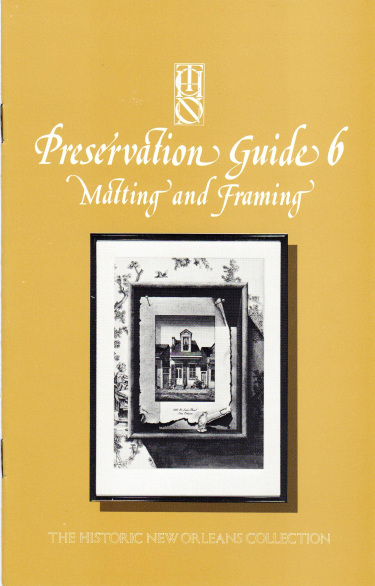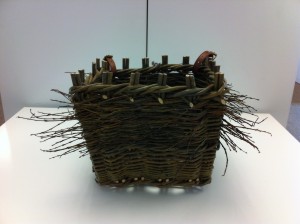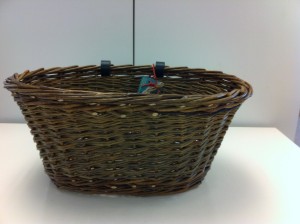|
Preservation
Guide 6: Matting and
Framing
 |
|
Preservation Guide 6: Matting and
Framing |
Preservation Guide 6:
Matting and Framing
Author: the Historic New
Orleans Collection. Preservation Guides by the Historic
New Orleans Collection provide clear, in-depth
collection care advice. Each guide has illustrative
photographs and drawings.
|
|
Storage
Facilities
Collections are stored in all
manner of facilities: barns, basements, attics, closets,
the second floor of historic houses and offsite storage
facilities. Some storage areas share a building with
other museum functions, such as exhibits or offices,
while others share space with non-museum functions such
as rental apartments, cafeterias or garages.
Ideal storage space has stable
relative humidity and temperature, no dust nor fumes,
light, pests, leaks nor fire hazards. It is easily
accessible, and the collection is organized, well
labeled and easy to retrieve. Finally, the space is
expandable to fit the needs of a growing collection. OK,
so the ideal never exists. Some museums get pretty
close, but even the best have the occasional dripping
sprinkler head, mouse incursion, or forgotten corner
piled with artifacts. Storage improvement is a process.
The Detroit Institute of Arts talks about "shifting up."
As improvements are made to one space, every other space
is improved a little as well. For example, buying
premium cabinets frees up adequate metal shelving that
will replace substandard wood shelving in another
storage space. Using a planned approach, with an overall
goal of ideal storage, these yearly advances contribute
to the overall improvement of preservation.
Excerpt from MS202 Museum
Storage Facilities and Furniture with instructor
Lori Benson starting on May 5, 2014. Come learn more
about planning your storage; determining the space you
will need; and many other details about museum
storage.
Lori Benson is an
independent museum professional based in Maine. Ms.
Benson has a B.A. in biology and a Masters of Library
and Informational Science specializing in rare books and
archives. She has taught museum studies to
undergraduates and given many talks and lectures on
preservation, deaccessioning, project planning and
moving. |
Regional Workshops
Where you can find some of our instructors this
year:
John
Simmons
Philadelphia Academy of Natural
Sciences
- "Integrated
Pest Management for Cultural Institutions," 13 May
2014
Philadelphia History Museum
- "Exhibitions
for Cultural Institutions" (with Julianne Snider), 07
October 2014
School
of Library and Information Science at Kent State
University
On-line
graduate workshop 07 April to 02 May 2014
Juniata
College in Huntingdon, Pennsylvania
Undergraduate
course 20 January to 06 May 2014
- "Museum
Education" (with Julianne Snider)
Forthcoming
publications:
- "Foundations
of Museum Studies: Evolving Systems of Knowledge" with
Dr. Kiersten F. Latham
- "Fluid
Preservation: A Comprehensive Reference"
- "Collection
Care and Management" in "Museum Practice," edited by
Conal McCarthy
Karin
Hostetter
National Association for
Interpretation
- May 6, 2014 1 - 2 pm (Mountain) webinar for
National Association for Interpretation on some aspect
on volunteer program management--specific topic still
to be decided
- Sept. 16, 2014 1 - 2 pm (Mountain) webinar
for National Association for Interpretation on some
aspect on volunteer program management--specific topic
still to be
decided
Yale
University, New Haven, CT
- Tuesday, April 22, 2014, 9:00 a.m. - 5:00
p.m. Certified Institutional Protection
Specialist/Supervisor (CIPS) Basic Protection Training
& Certification
- Tuesday-Thursday, April 22-24, 2014, 9:00 a.m. -
5:00 p.m. daily Certified Institutional Protection
Instructor (CIPI) Certification
American Alliance of Museums Annual Meeting,
Seattle, WA
- Wednesday, May 21, 2014, 12:00 - 4:00 p.m.
Management of Aggressive Behavior (MOAB)
- Thursday, May 22, 2014, 8:30 a.m. - 4:30 p.m.
Certified Institutional Protection Manager (CIPM)
Certification
|
|
American Alliance of Museums Annual
Meeting
May 18-21, 2014, Seattle, WA
Colorado-Wyoming
Association of Museums Annual Meeting
May
8-10, 2014, Cody, WY
Society For the
Preservation of Natural History Collections Annual
Meeting
June
22-28, 2014, Cardiff, Wales, UK
Association of
Midwest Museums Annual Meeting
July
14-17, 2014, St. Louis, MO
International
Foundation for Cultural Property Protection
Annual
Conference, Seminar, Exhibits & Certification
Program
August 9-14, 2014,
Denver, CO
Greater Than the Sum of
Our Parts, 2014 AASLH Annual Meeting
September
17-20, 2014, St. Paul, MN
Mountain-Plains
Museums Association Annual Meeting
September
28 - October 2, 2014, Aspen, CO
Western Museums
Association Annual Meeting
October
5-8, 2014, Las Vegas, NV
Southeast
Association of Museums Annual Meeting
October
20-22, 2014, Knoxville, TN
New England
Association of Museums Annual Meeting
November
19-21, 2014, Cambridge, MA |
|
|
Welcome to
the Collections Caretaker e-Newsletter from
Northern States Conservation Center. The
newsletter is designed to bring you timely and
helpful content that is pertinent to situations we
all encounter in our museum and archives work.
Feel free to let us know what topics you would
like to see featured in Collections Caretaker or
even contribute an article.
| |
|
2014
On-line Course Schedule
Released
|
|
Textiles and Their
Environment
By Ann Coppinger
Textiles are perhaps the
most fragile of all objects found in museum
collections. They degrade quickly when subjected
to poor environmental conditions, especially
excessive light, fluctuating temperature and
humidity, airborne pollution and biological pests.
If these factors are monitored and controlled,
generally it will prevent damage that may be
costly or possibly untreatable.
Light
All light exposure is
harmful to textiles. It will cause fibers to break
down and dyes to fade. Light damage is cumulative
and irreversible, occurring progressively.
Textiles will lose flexibility, becoming weak and
brittle. They will initially begin to fracture
along crease lines, and then break into fragments
and eventually powder. For textiles made from
cotton and linen, the degradation process will be
accompanied by general yellowing and
browning.
Since it is not reasonable
to keep your textiles in the dark all the time,
what you can do is limit the time, amount and type
of light exposure. Textiles can be kept in the
dark when galleries are closed and storage rooms
are unoccupied. Windows in storage and galleries
should be covered because natural light is
variable and loaded with damaging ultraviolet
radiation. Keep light levels for display at no
more than 50 lux or 5 footcandles, always avoiding
direct light on textiles.
Temperature and
Humidity
These two environmental
factors are interrelated. High air temperatures
have a greater capacity to hold moisture while
lower temperatures hold less moisture. This
explains why in the summer the air may seem heavy
or muggy, while in the winter static cling and
fly-away hair are problematic. Fluctuations in
temperature and humidity cause fibers to shrink
and swell, thus weakening the textile. Textiles
should be placed in a controlled environment with
a temperature of 70° F + or - 5° (21°C + or -
3°C) and a relative humidity of 50 percent, plus
or minus 5 percent. Textiles should not be stored
in attics or basements where humidity and
temperatures can be extreme. The optimum storage
area is in a central room within a building with
good air circulation. Temperature and humidity
levels should be recorded and monitored with a
recording hygrothermograph or datalogger in any
area where the collection is kept, including both
storage and display.
Airborne
Pollution
Dust and other airborne
atmospheric pollutants can settle on textiles and
cause severe damage. Dusts contain fine, sharp
particles that, if not removed, will eventually
become embedded into textiles and abrade fibers.
Dust contains mold spores, which under high
temperature and humid conditions, will flourish
and grow on textiles. Dust also provides
nourishment for insects and other pests. Good
housekeeping will serve to keep the level of
airborne pollutants at a minimum.
Biological Pests
Insects, rodents, mold and
mildew all view textiles not as wonderful objects
but as excellent sources of nourishment and really
comfortable homes. They will nest in or feed on
textiles causing small and big areas of loss.
Clothes moths and carpet beetles are attracted to
protein fibers; silk, wool, fur and feathers.
Silverfish feed on cellulose and starch found in
cotton and linen textiles. Mold and mildew grow in
warm, damp locations. Areas that contain
collections should be monitored and inspected on a
regular basis for infestations. An integrated pest
management plan (IPM) should be collection's first
line of defense.
Conclusion
It is important to
understand what causes damage to textiles, but at
the same time it might seem rather overwhelming to
correct all problems at once. Remember that
awareness of how to recognize problematic
situations together with small changes can often
result in damage prevention for your textile
collection.
Excerpt from Care of
Textiles course starting May 5. 2014
Ann Coppinger runs
the conservation department and teaches
conservation at the Fashion Institute of
Technology in New York. She has a master's in
museum studies specializing in costume and textile
conservation from FIT. She is a former NEA master
apprentice at the Textile Conservation Workshop.
Ms. Coppinger previously worked for 22 years in
fashion in New York City. She has degrees in both
fashion design and pattern making from
FIT. |
|
Care
of Basketry News
Care
of Basketry Instructor Sherry Doyal is based in
London but her interest in basketry spans all
areas. Here are some of her recent activities.
This
April Dr. Nancy Odegaard of the Arizona State
Museum and University of Arizona (also a Northern
States Conservation Center museum classes on-line
instructor) was in town. Nancy gave an illustrated
lecture at the University College, London
Institute for Archaeology. Nancy spoke about the
ASM culturally comprehensive assemblage of
basketry and cordage from the arid Southwest
region (nearly 27,000 items). A Save America's
Treasures grant in 2010 supported a condition
survey, storage room improvements, and specialized
storage furniture for the collection. Advances in
conservation treatment from the ASM lab for
basketry objects include new analytical techniques
and identification of indigenous repairs; new
treatment techniques using CO2-snow for cleaning
(http://www.co2clean.com/ );
calibration and identification methods using X-ray
and Xeroradiograph documentation; and new
procedures for reversal of failing restorations,
and stabilization of degraded pitched
surfaces. The lab continues to seek
tribal consultations to address cultural concerns
and inform the development of guidelines regarding
access, handling, and preservation of fibre-based
objects (some of which come from mortuary
contexts). ASM is working on an extensive review
of the conservation literature related to the
products used in the stabilization of
basketry. An informal reception which
followed Nancy's talk was a very happy occasion
reuniting colleagues and Nancy's former interns
now based in the UK.
To
contrast with the dry site basketry of the arid
Southwestern US Sherry has been organizing a panel
meeting late in April at the invitation Curator
Fiona Pitt of Plymouth City Museums of
conservators, basket makers and archaeologists to
look at an exciting Bronze age basket find from
Dartmoor National Park Devon, England (http://www.dartmoor-npa.gov.uk/aboutus/news/au-geninterestnews/prehistburial).
This basket is of coiled lime bast cordage
and has been conserved by Helen Williams at
Wiltshire & Swindon History Centre, Chippenham
and will part of an exhibition later this year.
The panel is meeting to look at replication of the
basket for the displays. Sherry has consulted with
Dr. Susanna Harris of University College London
who very generously shared her knowledge of lime
bast processing (http://forestry.oxfordjournals.org/content/78/1/65.abstract).
Sherry will attend a workshop to gain practical
experience of the process in May (for more
information on the workshop go to http://www.woodlandsurvivalcrafts.com/bushcraft-courses/).
To
increase interest in contemporary basketry Sherry
is organizing a display of bicycle baskets by
members of the Basketmakers' Association in
Knaresborough, North Yorkshire for June/July of
this year (for more information on the association
go to http://www.basketassoc.org/index.php).
Stages of the sporting Tour de France will take
place in England this year with 48 thousand cycle
enthusiasts predicted to arrive in Yorkshire. This
will be a great opportunity to showcase the
breadth of basket making with members providing
both traditional and modern versions. Sherry
called in on the Spring School run by the
Basketmakers' Association in the City of York this
week to collect baskets from makers for this
exhibit.
 |
|
Hairy biker's
basket by Cumbrian maker and grower
Susan Pettman in willow "Green Dicks" based on
an Irish
creel. |
 |
|
Edinburgh maker Anna Liebmann Coldham
in organic willow "Bleu" and "Brittany Green"
varieties. |
To
learn more about baskets and their care join
Sherry for the Care of Baskets course
starting May 5, 2014.
Sherry
Doyal is head of the organic artefacts
conservation section at the British Museum. She
now specializes in conservation of botanic
materials. Sherry has previous experience of
private practice conservation serving regional
historic houses, scientific botany collections
(herbaria) and small museums. Her employment
history also includes large museums (Metropolitan
Museum of Art, NY and Victoria and Albert Museum,
London). Sherry received a conservation and
restoration studies certificate with distinction
from Lincoln College of Art in 1980 and a post
graduate certificate in upholstery conservation
from the Textile Conservation Centre, Hampton
Court Palace in 1984. Sherry received a further
and adult education teachers' certificate from
Exeter College in 1998 and a diploma in design and
craft (constructed textiles) in the context of
basketry from City Literacy College, London in
2008. In her spare time she is a maker and
exhibitor of contemporary basketry
works. |
|
May 2014
Courses
MS109: Museum
Management
Instructor: Sue
Near
May 5 - Jun 13,
2014
Sound business practices
are critical for a museum to fulfill its mission.
Sounds like vegetables, right? Museum Management
is complex. A museum exists to preserve
collections and educate, but it is also an
institution that must employ sound business
practices while being accountable to the public as
a non-profit organization. Instructor Sue Near
teaches participants how to administer a
successful museum efficiently and effectively.
Participants will engage in discussions about the
changing cultural climate and its effect on museum
operations.
MS202: Museum Storage
Facilities and Furniture
Instructor: Lori
Benson
May 5 - May 30, 2014
The course will start with
a refresher on the agents of deterioration and
environmental issues to assure that the students
have a common base to begin. After this
introduction, topics include determining storage
and defining space, architectural design
considerations and issues such as lighting,
security and planning. We will discuss general
information about storage furniture types and
storage materials, how to modify existing cabinets
and information on homemade storage systems. The
last section includes specific information from a
variety of vendors, specifics on writing a Request
for Proposal (RFP), and what to consider when
making a decision on a furniture type and vendor.
The instructor will add readings and other
information depending upon the students and their
individual institutional problems and concerns.
MS212: Care of
Textiles
Instructor: Ann
Coppinger
May 5 - May 30,
2014
Caring for textiles demands
an understanding of how and why they deteriorate.
This course offers a simplified explanation of the
origin and structure of textile fibers as well as
the finished textile object; be it either a piece
of whole cloth or a finished garment. Care of
Textiles teaches students to identify fibers,
fabric structures and finishes, write condition
reports, and understand the agents of
deterioration that are harmful to various fabrics
both in storage on exhibit. Topics include
preparing textiles for storage and exhibit, the
use of archival materials with textiles, and three
dimensional supports.
MS225: Care of
Baskets
Instructor: Sherry
Doyal
May 5 - Jun 13,
2014
Baskets are an important
part of nearly every world culture. Caring for
baskets requires an understanding of why and how
they deteriorate. Care of Baskets provides a
simplified explanation of the chemistry and
structure of basketry materials. Starting with an
overview of the history and function of baskets
and how they are made, Care of Baskets will cover
guidelines for handling, labeling, exhibiting and
storing baskets, including condition assessments
and an introduction to integrated pest management.
An overview of treatments used on baskets and how
appropriate they are for the long-term
preservation of the basket will help students make
care decisions when consulting with
conservators.
MS233: Matting and
Framing
Instructor: Susan
Duhl
May 5 - May 30,
2014
Matting and Framing teaches
the materials and techniques of
conservation-quality framing. For display, matting
and framing provides both protective and aesthetic
contributions to art on paper. Students will learn
about different types of enclosures, different mat
styles and cutting methods, the pros and cons of
different backing boards and glazing, and
different methods of attaching items to a mat,
some of which do not involve adhering hinges to
art on paper. Lectures, illustrations, product
resources, and additional informational references
will be provided.
MS011: Gallery Guides
(short course)
Instructor: Karin
Hostetter
May 12 - May 16,
2014
Self-guided brochures,
exhibit labels, docent led tours, guest speakers,
and audio tours are only a few of the methods
available to guide visitors through an exhibit.
Explore the strengths and challenges of many
different methods and garner resources for further
information. Learn how to determine which method
works best with which exhibits and how to provide
variety to enhance the visitor
experience. | |
|
|
Submissions and
Comments
How to submit
an article or upcoming workshops for inclusion in
the Newsletter:
If you would like to submit
an article, notice of an organizational meeting or
upcoming workshop for an upcoming Collections
Caretaker Newsletter, send your submission to peggy@collectioncare.org.
We are always looking for
contributions to this newsletter. Submission
deadline is the 10th of each
month.
Have a comment
or suggestion?
Send it to peggy@collectioncare.org |
Northern States
Conservation Center (NSCC) provides training,
collection care, preservation and conservation
treatment services. NSCC offers online museum
studies classes at www.museumclasses.org
in Collections Management & Care, Museum
Administration & Management, Exhibit Practices
and Museum Facilities Management.
Sincerely,
Helen Alten,
Director
Peggy
Schaller, Publications
Manager | | |